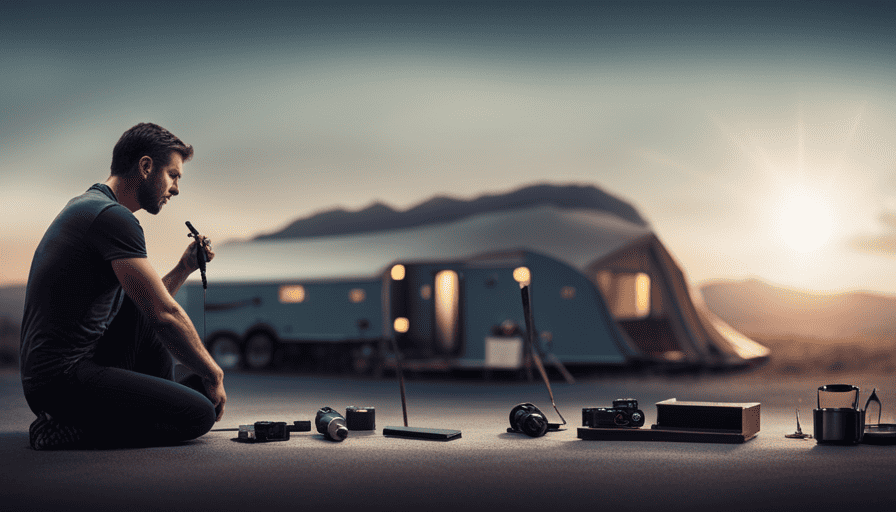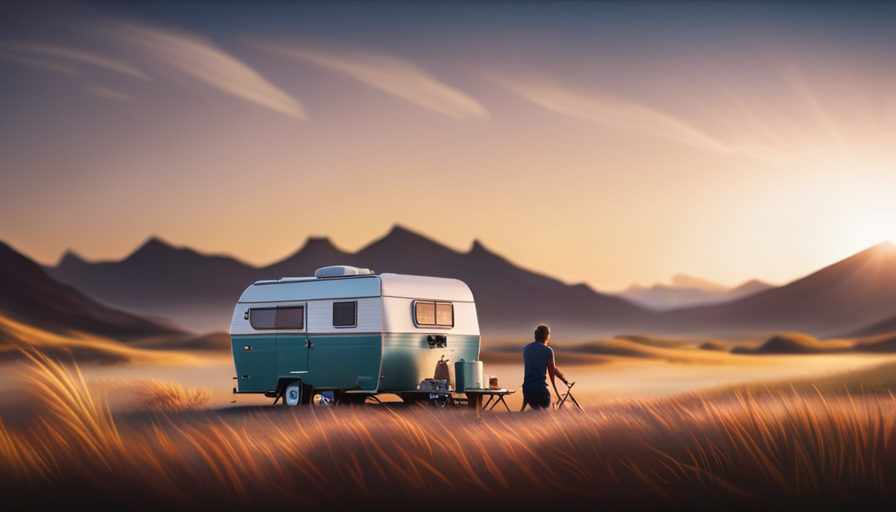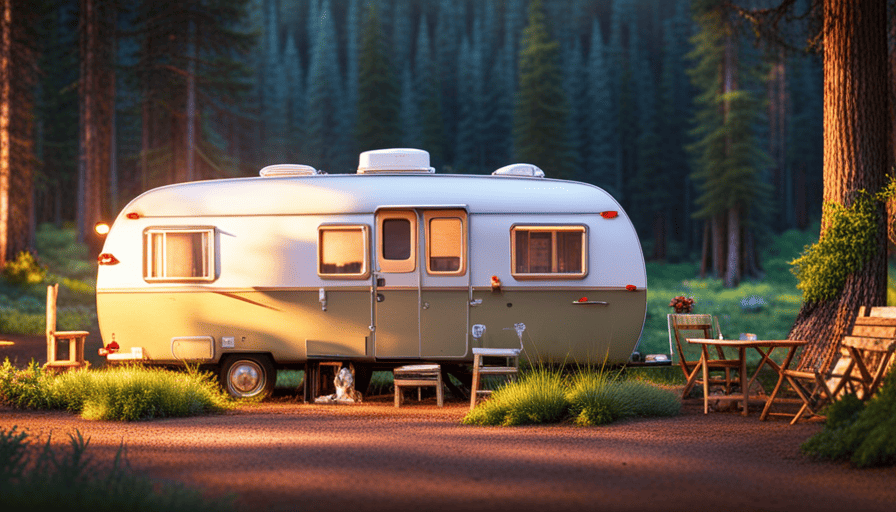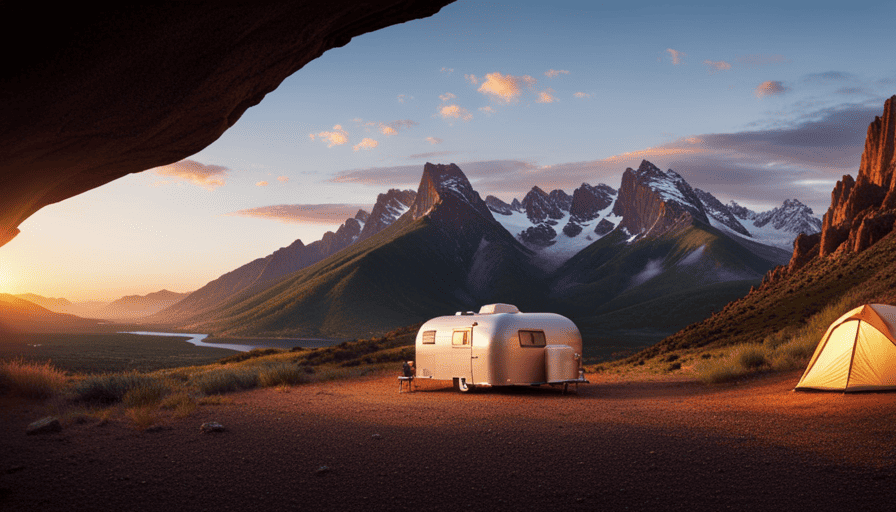So, you’re looking to set off on the magnificent quest of constructing your own camper? Well, buddy, brace yourself for a thrilling ride packed with sawdust, power tools, and an immense amount of creativity. Crafting a camper from scratch is a significant undertaking, but armed with the correct attitude and a useful collection of skills, you can bring to life your personalized mobile abode.
In this article, I will guide you through the step-by-step process of constructing your dream camper. From selecting the perfect base vehicle to customizing the interior with all the creature comforts you desire, we will leave no stone unturned.
With a methodical approach and attention to detail, we will build a sturdy frame, install essential systems, and add those finishing touches that will make your camper truly one-of-a-kind.
So, grab your tool belt and let’s get started on this exhilarating DIY adventure. By the end, you’ll be ready to hit the open road in a camper that is as unique as you are.
Let’s dive in and unleash our inner campervan architect!
Key Takeaways
- Selecting the right base vehicle is crucial, considering budget, materials, and desired features.
- Planning and designing the layout of the camper should consider the number of people, sleeping areas, windows, storage solutions, and budget.
- Gathering necessary materials and tools, including a drill, saw, measuring tape, level, and safety equipment.
- Customizing the interior with furniture, appliances, lighting, and decor, while considering comfort and functionality.
Determine the Type of Camper You Want to Build
Now that you’ve decided to build a camper, let’s figure out what type of camper you want to build. The first step in this process is determining your budget. Building a camper can range from a modest DIY project to a high-end, customized build. Setting a budget will help you narrow down your options and ensure that you don’t overspend.
Consider factors such as your financial situation, desired features, and timeline for completion.
Once you have a budget in mind, it’s time to choose the materials for your camper. The materials you select will depend on various factors, including your budget, desired aesthetics, and durability requirements. Common materials for camper builds include plywood, aluminum, fiberglass, and steel. Each material has its pros and cons, so it’s important to research and consider how they align with your goals.
By determining your budget and choosing materials, you’ll have a solid foundation for your camper build. The next step is to choose the right base vehicle, which will serve as the starting point for your project. With a clear idea of your budget and materials, you can confidently move forward in creating your dream camper.
Choose the Right Base Vehicle
To ensure you select the ideal base vehicle for your adventure, consider researching and comparing various options, such as vans, trucks, or SUVs, based on their size, towing capacity, and off-road capabilities.
Here are four important factors to consider when choosing the right base vehicle for your camper:
-
Size: Determine how much space you need for your camper. Consider the number of people you’ll be traveling with and the amount of gear you’ll be carrying.
-
Towing capacity: If you plan on towing a trailer or additional equipment, make sure the base vehicle has sufficient towing capacity to handle the load.
-
Off-road capabilities: If you’re planning to venture off the beaten path, look for a base vehicle with good off-road capabilities. Consider features like four-wheel drive, ground clearance, and suspension.
-
Budget considerations: Set a realistic budget for your camper build and take into account the cost of the base vehicle. Keep in mind that older vehicles may require more maintenance, while newer models may come with a higher price tag.
Choosing the right base vehicle is crucial to the success of your camper build. Once you’ve made your decision, you can proceed to the next step of planning and designing the layout of your camper.
Plan and Design the Layout of Your Camper
Consider mapping out and visualizing the layout of your dream adventure mobile, envisioning the perfect arrangement of living, sleeping, and storage spaces for your needs and comfort.
When planning the layout of your camper, there are several design considerations to take into account. Firstly, think about how many people will be using the camper and what their needs are. This will help you determine the number and size of sleeping areas required.
Additionally, consider the placement of windows and doors to maximize natural light and airflow. Efficient storage solutions, such as overhead cabinets and under-bed compartments, are also important to keep your space organized and clutter-free.
Budget planning is another crucial aspect of designing your camper’s layout. Determine how much you’re willing to spend on materials and furnishings. Research affordable options and prioritize essential items. This will help you stay within your budget while still creating a functional and comfortable living space.
Once you’ve finalized the design and budget, the next step is to gather the necessary materials and tools. By carefully planning and designing your camper’s layout, you can ensure that it meets your specific needs and provides a comfortable and enjoyable environment for your adventures ahead.
Gather the Necessary Materials and Tools
Get ready to embark on your adventure by gathering all the materials and tools you’ll need to bring your dream mobile living space to life. Choosing the right tools is essential for a successful camper build. Look for high-quality tools that are durable and suited for the specific tasks involved.
Some essential tools include a drill, saw, measuring tape, level, and various hand tools like screwdrivers and wrenches.
Next, finding affordable materials is key to staying within your budget. Consider visiting local salvage yards, architectural salvage stores, or online marketplaces to find used materials such as windows, doors, and flooring. You can also save money by repurposing items like cabinets or countertops from old kitchens. When it comes to lumber, opt for sustainable and cost-effective options like plywood or reclaimed wood.
Additionally, don’t forget to stock up on safety equipment like gloves, goggles, and a dust mask to protect yourself during the construction process.
Once you have gathered all the necessary materials and tools, you’ll be ready to move on to the next step: building the frame and structure of your camper. This crucial stage will lay the foundation for the rest of your camper build, bringing you one step closer to your dream mobile home on wheels.
Build the Frame and Structure of Your Camper
Once you’ve gathered all the necessary materials and tools, it’s time to start constructing the sturdy framework and structure of your dream mobile living space. Building the frame and structure of your camper is a crucial step in the construction process because it provides the foundation for the rest of the build. Here are four essential building techniques and safety precautions to keep in mind:
-
Measure and cut the lumber: Accurate measurements are vital for a solid structure. Use a tape measure and circular saw to cut the lumber to the required lengths.
-
Assemble the frame: Start by building the base of the camper, securing the floor joists to the frame. Then, install the wall studs and cross beams to create the walls and roof structure.
-
Reinforce the joints: Strengthen the frame by adding metal brackets or screws at the joints. This’ll ensure that your camper remains stable and secure during travel.
-
Use safety equipment: Wear gloves, safety glasses, and a dust mask when working with tools and materials. Also, use clamps or a helping hand to secure pieces in place, minimizing the risk of accidents.
With the frame and structure complete, it’s time to move on to the next step: installing insulation and wiring. This’ll provide comfort and functionality to your camper while on the road.
Install Insulation and Wiring
After completing the frame and structure, it’s time to enhance the comfort and functionality of your mobile living space by installing insulation and wiring.
Insulation is crucial in maintaining a comfortable temperature within your camper, and there are various types to choose from. Fiberglass insulation, for example, is commonly used due to its affordability and effectiveness in reducing heat transfer. Another option is foam insulation, which provides excellent thermal and sound insulation properties. It’s important to carefully install insulation in all walls, floors, and ceilings to ensure maximum efficiency.
When it comes to wiring, safety is paramount. Start by planning the layout of your electrical system, taking into consideration the power needs of your appliances and lighting fixtures. Use proper wire gauges and connectors to ensure a reliable and safe electrical system. It’s also important to follow electrical codes and regulations to prevent any potential hazards.
As you finish installing insulation and wiring, you can now move on to the next step in building your camper: customizing the interior with furniture and storage. This will allow you to create a cozy and functional living space that meets your specific needs and preferences.
Customize the Interior with Furniture and Storage
Now it’s time to make your mobile living space truly unique and functional by personalizing the interior with furniture and storage options that perfectly suit your needs and style.
When it comes to the furniture arrangement in your camper, it’s important to consider both comfort and functionality. Start by measuring the available space and planning out where each piece of furniture will go. Consider using multi-functional furniture, such as a sofa that can also serve as a bed, or a table that can be folded away when not in use. This will help maximize the limited space in your camper.
Storage solutions are also crucial in a camper, as you’ll need to make the most of every available inch. Look for furniture pieces that offer built-in storage, such as ottomans with hidden compartments or beds with drawers underneath. Additionally, consider installing shelves, hooks, and organizers on the walls to keep items organized and easily accessible. Utilize vertical space by adding overhead cabinets or installing storage bins under seats.
When customizing the interior of your camper, it’s important to strike a balance between functionality and aesthetics. Choose furniture pieces and storage solutions that not only serve a purpose but also reflect your personal style. Consider the color scheme and materials used, as they can greatly impact the overall ambiance of your space.
Next, we’ll delve into the installation of essential systems and appliances, which will further enhance the functionality of your camper and make it feel like a home away from home.
Install Essential Systems and Appliances
Enhance your mobile living experience by installing essential systems and appliances that’ll transform your camper into a comfortable and functional home on wheels.
When it comes to creating an efficient and sustainable living space, energy-efficient systems are a must. Consider installing solar panels to power your camper and reduce your reliance on traditional energy sources. Additionally, invest in LED lighting fixtures to minimize energy consumption and extend battery life.
Choosing the right appliances is crucial to ensure convenience and functionality in your camper. Opt for compact yet efficient appliances such as a mini-fridge, a propane stove, and a microwave oven. These appliances won’t only save space but also provide you with the necessary amenities for cooking and storing food.
To further enhance your camper’s functionality, consider installing a water filtration system. This’ll allow you to have clean and drinkable water wherever you go. Additionally, a heating and cooling system will keep you comfortable during extreme weather conditions.
By incorporating these energy-efficient systems and carefully selecting the right appliances, you can create a camper that meets your specific needs. With the essential systems and appliances in place, you can now move on to adding the finishing touches and decorations that’ll truly make your camper feel like home.
Add Finishing Touches and Decorations
To truly make your camper a cozy and personalized haven, infuse it with your unique style and personality through carefully chosen finishing touches and decorations.
Finishing touches can really elevate the overall aesthetic and functionality of your camper. Consider adding curtains or blinds to provide privacy and block out sunlight when needed. You can also add throw pillows and cozy blankets to make the seating area more comfortable and inviting. Don’t forget about lighting! String lights or battery-operated LED lights can create a warm and cozy ambiance.
When it comes to decorations, the possibilities are endless. Hang up artwork or photographs that inspire you and make you feel at home. Use wall decals or stickers to add a touch of personality to the interior. Plants can also bring life into your camper and make it feel more vibrant. Opt for small, low-maintenance plants that can thrive in a mobile environment.
Consider incorporating storage solutions that are both functional and decorative. Utilize bins, baskets, and shelves to keep your belongings organized while adding a stylish touch.
With the right finishing touches and decorations, your camper will truly feel like a home away from home.
As you finish adding those final touches, it’s essential to test and inspect your homemade camper before hitting the road to ensure everything is in working order.
Test and Inspect Your Homemade Camper before Hitting the Road
Before you hit the road, make sure to thoroughly test and inspect your homemade camper to ensure that everything is in proper working order. Inspecting the safety and testing the functionality of your camper is crucial for a smooth and stress-free journey. Here is a step-by-step guide to help you in this process:
| Inspection Point | Action Required |
|---|---|
| Electrical system | Check all wiring connections, test lights, outlets, and appliances. |
| Plumbing system | Inspect pipes, faucets, and drains for any leaks. Test the water pump and ensure proper water flow. |
| Gas system | Check for gas leaks, test the stove, refrigerator, and heating system. |
| Structural integrity | Inspect the roof, walls, and floor for any signs of damage or weakness. Ensure all doors and windows open and close properly. |
In addition to the table, here are some additional tips to consider during your inspection:
- Test all safety features, such as smoke detectors and carbon monoxide alarms.
- Check the tires for proper inflation, tread depth, and any signs of damage.
- Inspect the brakes and ensure they are functioning correctly.
- Test the emergency exits and make sure they are easy to open and close.
By following these steps and conducting a thorough inspection, you can ensure that your homemade camper is safe, functional, and ready for your next adventure on the road.
Frequently Asked Questions
How much does it typically cost to build a camper?
Typically, the cost to build a camper can vary depending on whether you choose to go the DIY route or hire professionals. DIY builds tend to be more cost-effective, with an average cost breakdown including materials, tools, and any necessary permits.
However, if you opt for a professional build, expenses can increase significantly due to labor costs and customization options. It’s important to carefully consider your budget and desired level of involvement before making a decision.
What are some common mistakes to avoid when building a camper?
Ah, the joy of building a camper. It’s a thrilling adventure filled with countless opportunities to make mistakes. But fear not, fellow builders, for I’ve gathered some invaluable tips and tricks to guide you through this treacherous journey.
First and foremost, avoid overlooking the importance of proper insulation and ventilation. Neglecting these crucial elements can turn your cozy camper into a suffocating sauna.
Additionally, be meticulous with your measurements to prevent any ill-fitting components.
Happy building!
Can I legally drive a homemade camper on the road?
Yes, you can legally drive a homemade camper on the road. However, there are certain legal requirements that must be met. These requirements vary by state, but typically include obtaining a special vehicle registration or title, passing safety inspections, and meeting specific criteria for dimensions and equipment. Additionally, it’s important to have the proper insurance coverage for your homemade camper to protect yourself and others in case of an accident.
Are there any specific building codes or regulations I need to follow when building a camper?
When it comes to building a camper, it’s essential to be aware of the building codes and regulations in place. These guidelines ensure the safety and structural integrity of your creation. Building codes for campers typically cover aspects such as electrical systems, plumbing, ventilation, and fire safety.
Additionally, building regulations may vary depending on your location. It’s crucial to research and adhere to these codes and regulations to ensure your camper meets all necessary requirements.
How much time does it usually take to build a camper from start to finish?
Building a camper from start to finish typically takes around 4-6 months, depending on the complexity of the design and the amount of time you can dedicate to the project.
It’s important to have the essential tools for the job, such as a circular saw, drill, measuring tape, and screwdriver set.
Taking a methodical approach and carefully planning each step will ensure a successful and efficient building timeline.
Are the Steps to Build a Truck Bed Camper Similar to Building a Regular Camper?
When it comes to DIY projects, building your own truck bed camper can be a rewarding endeavor. But are the steps similar to building a regular camper? While some aspects may overlap, the size and design considerations make building a truck bed camper unique. With careful planning and attention to the specific dimensions of your truck, you can create a customized build your own truck bed camper that suits your adventurous lifestyle.
Conclusion
In conclusion, building your own camper can be a rewarding and fulfilling experience. By following the steps outlined in this article, you can create a personalized and unique space that suits your needs and style.
Just like a skilled craftsman, you’ll carefully select the materials and tools, design the layout, and construct the frame and structure of your camper.
With attention to detail and a touch of creativity, you can transform a simple vehicle into a cozy home on wheels.
So, why settle for ordinary when you can create something extraordinary? Start your camper-building journey today and hit the road with confidence!











